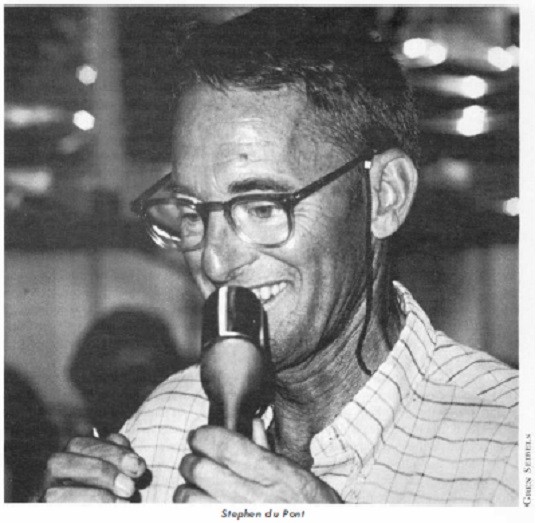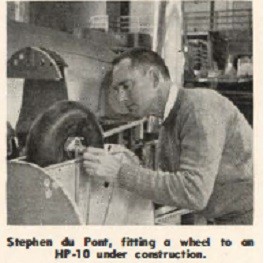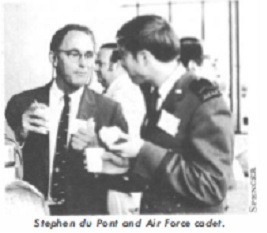Stephen du Pont
1987
about
(1915-2012) SSA Director; Sailplane Safety/Construction, SOARING Columnist; Author
Awards
Silver #377 1959; Gold #252 1965; Diamond #112 (Int #762) 1969
Bio

Several members of the du Pont family were involved in scientific endeavors and flying sailplanes. Many of them attended the Massachusetts institute of Technology (MIT) and participated with the glider club -- the Aeronautical Engineering Society (AES) as did several other members of the Soaring Hall of Fame. Steve du Pont was one of the most prominent of these du Ponts. Richard, in the first group elected to the Hall of Fame (1954), is his cousin. Steve was born in Wilmington, DE in 1915, one of six brothers, five of whom were licensed pilots.
Steve du Pont joined the AES when he was a freshman at MIT. At the time the club owned a Franklin Glider. Steve had an hour or two of flight instruction. Six or eight of the club members, after exams in 1935, went to Concord, NH to fly. They had obtained permission for the use of the airport. So they took the single-seat Franklin on a trailer, made their way to Concord and proceeded to teach themselves to fly using ground launch.
They started by auto towing to three feet, releasing and learning to land. Next, they towed up to fifty feet, turned right down the runway and, once again, landed. At last, when they thought they were ready, they towed high enough, maybe 150 or 200 feet, to make a 360 degree flight around the air field.
They went to Elmira for the National competition. However, they did not have pilot licenses. The organizers told them they had to have pilot licenses to fly in the Nationals. There was an inspector named Toomey there from the Department of Commerce. In order to get the license, they had to make an auto tow followed by a 360 degree turn and landing. Thus Steve earned his pilot's license.
Steve's cousin Richard du Pont, whom Steve knew very well - probably because of their shared interests - had a Bowlus Albatross. Steve's brother Paul built a winch which had been designed by their Father - a GMC truck (now in the National Soaring Museum at Elmira). The group had several adventures learning to use winch tow.
Steve then decided to get his powered airplane license. However, he only had one eye so he had to fly twice as many hours to get a pilot license - 100 hours. He bought a well used Fleet with a Kinner engine and accumulated the 100 hours.
Steve's first job was working for Bellanca as a draftsman sitting at a table with five or six others making drawings of the engineers' inventions. Perhaps that is what encouraged him to go back to school. He then went to work for Indian Motorcycles in Springfield, MA where he was Chief Engineer doing development work on the first auxiliary power packages made for the Glenn Martin flying boats.

He was active in flying airplanes having owned several including the Fleet, a Monocoupe, Cessna Airmaster, Fairchild 24, Seabee, Waco YMF, Bellanca and others. He worked for Doman Helicopters in 1949 where he was Director of Research and Development and filed several patents related to hingeless helicopter rotors. He formerly chaired the helicopter Committee of the Society of Automotive Engineers. He had held a helicopter pilot rating since 1953.
After a 24 year absence, in about 1960, he returned to flying sailplanes with the Nutmeg Soaring Association in Connecticut and became an SSA Regional Director representing the New England area (Region 1).
His company, Helisoar, manufactured kit aircraft including all parts. He cooperated with Dick Schreder to produce kits for his HP-10 sailplane design. Steve flew several national competitions but never did very well.

His great love was writing - especially about safety of flight. He has written extensively for SSA, AOPA and EAA and published several aviation books. Perhaps his first article appeared in The Gliding and Soaring Bulletin - the predecessor of Soaring magazine. His frequent articles for Soaring magazine include Soaring by the Numbers, Soaring Accidents That Almost Happened, Staying Safe in Sailplanes. His paper, Safer Landings Through Understanding Visual Pattern Angles was quoted by the astronaut Storey Musgrave as playing an important role in learning to land the space shuttle. Steve du Pont earned his Silver # 377 in 1959, Gold #252 in 1965 and Diamond #112 (Intl #762) in 1969.